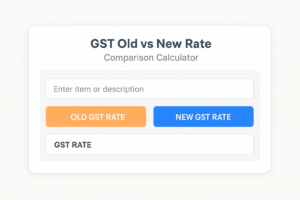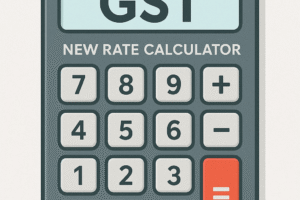New GST Rates in India 2025
The Goods and Services Tax (GST) Council has announced several important updates. These changes affect daily-use products, apparel, footwear, food items, and even luxury goods. Let’s break down the new GST rate 2025 updates in a simple way.
New GST Rates
GST Rate Unchanged at 5%
Some products will continue to attract 5% GST without any modification. This means consumers won’t see any price hike in these categories.
Affordable Apparel (up to ₹2500): Both knitted and non-knitted clothing items, if priced under ₹2500 per piece, will stay in the 5% GST bracket.
Textile Sets & Made-ups: Household textile items such as stitched sets, priced within ₹2500, remain at 5%.
Cotton Quilts: Quilts costing up to ₹2500 per piece are unaffected and will continue to be taxed at 5%.
GST Rate Unchanged at 18%
A few items remain unchanged at the 18% GST slab.
Premium Footwear: Shoes or sandals priced above ₹2500 per pair still fall under the 18% GST category.
👉 This ensures luxury footwear continues to be taxed higher than budget-friendly options.
GST Reduced from 18% to Nil (0%)
From 18% to Nil (0%)
The government has provided big relief by removing GST completely on some essential and specialised products.
Indian Breads: Items like paratha, parotta, chapati and other similar breads are now fully exempt from GST. This is a win for households and restaurants.
Technical Documentation: Paperwork linked to goods exempted under Customs Notification No. 19/2019 will now attract 0% tax.
Natural Diamonds (up to 0.25 carat): Imported under the Diamond Imprest Authorization Scheme, these are now GST-free.
Works of Art & Antiques: Art collectors and antique traders benefit from GST exemption.
Defence & Aerospace Equipment:
Flight and target motion simulators
Ejection seats for fighter aircraft
High-performance batteries for drones
Naval and underwater vessels
Ship-launched missiles & rockets above 100mm calibre
Remote-piloted aircraft (military use)
Communication devices and accessories for armed forces
👉 These exemptions show a clear push to support defence manufacturing, diamond trade, and Indian food industry.
GST Reduced from 5% to Nil (0%)
From 5% to Nil (0%)
A number of essential goods that earlier carried 5% GST are now completely exempted. This makes them more affordable for households.
Ultra-High Temperature (UHT) Milk: Long-life packaged milk, often used in cities, is now GST-free.
Paneer (Chena): Pre-packaged and labelled paneer is exempt from GST, reducing the cost of this popular protein-rich food.
Pizza Bread: No GST is charged on pizza bases, making dining and bakery products cheaper.
Khakhra, Chapati, and Roti: Traditional Indian foods now come under 0% GST, encouraging daily consumption.
Medicines: Several lifesaving drugs such as Agalsidase Beta, Imiglucerase, and recombinant coagulation factors are fully exempt.
Stationery: Erasers are now GST-free, benefiting students and schools.
From 12% to Nil (0%)
From 12% to Nil (0%)
Some products previously taxed at 12% are now in the zero-tax bracket, especially healthcare and education-related goods.
Medicines & Injections: High-cost treatments like Onasemnogene, Mepolizumab, Daratumumab, Alectinib, and many more are now GST-exempt. This is a huge relief for patients with rare and chronic conditions.
Educational & Office Items:
Maps, atlases, and wall charts are now tax-free.
Exercise books, graph books, and laboratory notebooks are also exempt.
Pencils, crayons, pastels, chalk, and sharpeners are included in this category.
Paper Products: Uncoated paper and paperboard used for notebooks are also brought under the 0% GST slab.
GST Reduced from 12% to 5%
From 12% to 5%
In some cases, the government has not fully removed GST, but reduced it from 12% to 5% — especially on daily-use food and household products.
Dairy Products: Condensed milk, butter, ghee, cheese, and dairy spreads now attract only 5% GST.
Affordable Footwear: Shoes and sandals priced up to ₹2500 per pair are now taxed at 5% instead of 12%.
Nuts & Dry Fruits: Almonds, pistachios, chestnuts, hazelnuts, macadamia nuts, pine nuts, and more are cheaper with just 5% GST.
Household Essentials: Tooth powder, candles, matches, and feeding bottles (with nipples) all fall into the reduced slab.
Bags & Utensils: Cotton and jute handbags, kitchenware made of wood, porcelain, china, steel, copper, aluminium, and brass are now more affordable.
Daily Utilities: Sewing needles, bicycles (non-motorised), umbrellas, hurricane lanterns, combs, and baby diapers have shifted to the 5% bracket.
Fruits (Dried): Dates, figs, guavas, pineapples, mangoes (dried), citrus fruits, and dried fruit mixtures also now come under the 5% GST rate.
Animal & Marine Oils: Various fats and oils derived from animals, fish, and poultry now attract 5% GST.
Packaged Foods: Sausages, preserved meat, jams, jellies, pasta, confectionery, namkeens, diabetic foods, and ready-to-eat snacks are cheaper.
Drinks: Tender coconut water, fruit-based beverages (non-carbonated), soya milk drinks, and milk-based drinks are now at 5%.
Agricultural & Renewable Energy Equipment: Tractors (below 1800 cc), drip irrigation systems, sprinklers, solar water heaters, and renewable energy devices are shifted to 5%.
Textiles: Yarn, felt, carpets, embroidery, sewing machines, bamboo furniture, and many textile accessories are also part of this reduction.
Healthcare: Medicines, diagnostic kits, glucose monitoring systems, spectacles, surgical items, and medical devices are included.
Stationery & Toys: Geometry boxes, colouring sets, toys, sports goods, and even board games are reduced to 5%.
GST Reduced From 28% to 18%
From 28% to 18%
Some commonly used products have seen a reduction in GST burden from 28% to 18%.
Cooling & Home Appliances: Air-conditioners and dishwashers now attract only 18%.
Electronics: LED/LCD TVs, monitors, projectors, and set-top boxes are taxed at 18% instead of 28%.
Vehicles:
Smaller petrol cars (up to 1200cc, under 4 meters)
Diesel cars (up to 1500cc, under 4 meters)
Three-wheelers
Ambulances and goods transport vehicles
Vehicle Parts: Chassis with engines, bodies, seats, and accessories for vehicles are taxed at 18%.
Motorcycles: Two-wheelers up to 350cc, including mopeds, are now cheaper under the 18% slab.
GST Rate Hikes from 28% to 40%
From 28% to 40%
Some high-end and luxury products now attract 40% GST, making them more expensive.
Pan Masala & Tobacco Products: All forms of tobacco, cigars, cigarettes, and pan masala now face the highest tax rate.
Aerated & Caffeinated Drinks: Soft drinks, carbonated fruit beverages, and energy drinks are shifted to the 40% slab.
Luxury Vehicles & Yachts: Motor cars, racing cars, motorcycles above 350cc, aircraft for personal use, and yachts for leisure all attract 40% GST.
👉 This hike ensures that luxury and harmful products contribute more tax revenue.
GST Rate Hikes From 12% to 18%
From 12% to 18%
Certain textile and paper products have been moved to a higher GST slab of 18%.
Apparel & Quilts: Clothes, accessories, and quilts priced above ₹2500 now fall under the 18% rate.
Textile Articles: Items made of quilted textile material exceeding ₹2500 are included.
Paper & Board Products:
Dissolving-grade wood pulp
Uncoated and coated paper (used for printing, packaging, and writing)
Kraft paper and greaseproof/glassine papers
Corrugated and composite paperboards
👉 The aim here is to increase tax revenue from premium textiles and industrial paper products, without burdening daily-use items like school notebooks (which are exempted).
Why These GST Changes Matter
The new GST rates 2025 bring a mixed impact:
Everyday items like milk, paneer, roti, stationery, medicines are now more affordable.
Luxury goods, harmful products (like tobacco & pan masala) face higher taxes.
The government is encouraging education, healthcare, farming, and renewable energy by reducing or removing GST in these sectors.
On the other hand, premium textiles, paper, and high-end vehicles will see a price rise due to increased rates.
You may also like

New GST Rate Finder

GST Old vs New Rate Comparison Calculator
15 Content Ideas for Small Businesses
If you’re a small business owner, you probably know that creating good content is important. But what content should you make? Whether it’s for your website, social media, or emails, content is key to digital marketing. Good content helps you …